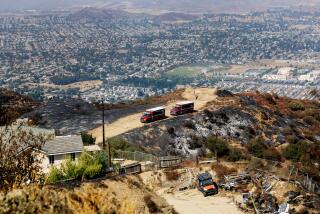Firefighters Gaining on Blaze Near Cajon Pass
- Share via
RANCHO CUCAMONGA, Calif. — More than 1,100 firefighters appeared Thursday night to have the upper hand on two San Bernardino County fires that blackened 7,000 brushy hillside acres and prompted the evacuation of about 250 homes west of Cajon Pass.
Hot Santa Ana winds, which had been gusting up to 60 m.p.h., had generally eased and the flames were moving back up the slopes away from residences. Nevertheless, at nightfall erratic winds continued to create several firestorms in the canyons.
The Texas Mountain fire, which broke out Wednesday morning at the mouth of Duncan Canyon near Lytle Creek, was considered 55% contained.
But California Department of Forestry spokeswoman Holly Kress refused to be overly optimistic, saying, “It’s still too squirrelly to predict full containment because of erratic Santa Ana winds.”
The other fire, which had burned 675 acres near Glen Helen Park near Cajon Pass, was said to be 90% contained. It began as a controlled burn that flared out of control on Wednesday, just about the time the Texas Mountain fire erupted 5 miles away.
Cause of the Texas Mountain blaze was under investigation. U.S. Forest Service fire information officer Mary Chislock called it highly suspicious.
That fire destroyed a large ranch house and two outbuildings, with loss estimated at $350,000. It also caused about $80,000 damage to a mushroom farm owned by George Hsieh, 38, north of Rancho Cucamonga. Hsieh said his shiitaki mushrooms, which are sold to Asian restaurants and markets for $15 a pound, were not insured because “insurance policies don’t cover mushrooms.”
Three people were reported injured. One was a resident of the area who suffered smoke inhalation. The others were inmate firefighters, one of whom had burned feet and the other a leg injury.
Residents along the north fringes of Etiwanda and Rancho Cucamonga were advised to leave at 5 a.m. Thursday as the flames zig-zagged through dry chaparral and eucalyptus groves. It was not known how many actually left, but most were back in their homes by Thursday afternoon.
Only four hours before the evacuation order, the fire had been fanned back to life after seeming to die down. “The winds picked up,” Kress said, with gusts of 50 to 60 m.p.h. giving the flames new ferocity.
The Interstate 15 freeway into Cajon Pass was closed for a couple of hours on Thursday--as it had been on Wednesday--because of dense smoke.
Meanwhile, President Reagan declared a disaster in four Northern California counties, enabling victims of wildfires there to receive federal grants, low-interest loans and temporary housing.
More to Read
Sign up for Essential California
The most important California stories and recommendations in your inbox every morning.
You may occasionally receive promotional content from the Los Angeles Times.











